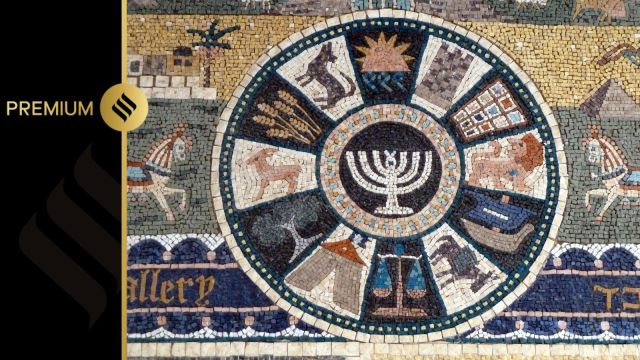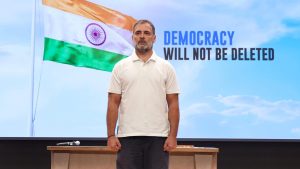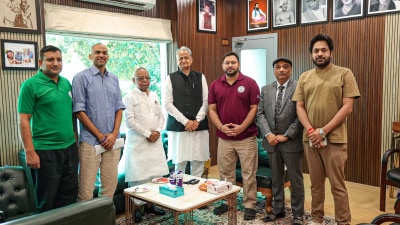For 84-year-old Natan Mangsat Kipgen, his return to Israel wasn’t just a homecoming; it was the culmination of a promise his ancestors had clung to for generations. While he now lives in Kiryat Arba in the land of his biblical forefathers, he feels a part of his heart remains in Petach Tikva, Manipur, where some of his children and grandchildren still wait, their journey delayed by forces beyond their control.
Kipgen is a member of the B’nei Menashe, a Jewish community from Northeast India who trace their lineage to the ancient lost tribe of Menashe. For him and many others, these delays represent the ongoing wait of a people torn between two lands, for a promise yet to be fully realised. “It has been more than 20 years now,” Kipgen says, “and none of my family has made Aliyah (the immigration of Jews to Israel).”
The B’nei Menashe community traces its origins to the Chin, Kuki and Mizo tribes, a small group from Manipur and Mizoram. In the 1970s, this community began studying and practising Judaism, motivated by a deep-seated belief that they were descendants of the biblical tribe of Menashe, one of the ‘lost tribes of Israel’, whose story is deeply rooted in Jewish history.
The Hebrews, led by their patriarch Abraham, believed in one omnipotent God. His descendants, through Isaac and Jacob, formed the Twelve Tribes of Israel, each assigned a territory in the Promised Land, Canaan. This unified tribal identity under King David and King Solomon would eventually fracture, with the tribes of Judah and Benjamin forming the Southern Kingdom and the remaining 10 tribes forming the Northern Kingdom, writes cultural anthropologist AE Cooper in Conceptualizing Diaspora: Tales of Jewish Travelers in Search of the Lost Tribes.
The Northern Kingdom, however, would not stand the test of time. In 722 BCE, the Assyrians invaded and exiled the people of Israel, leading to the disappearance of the 10 northern tribes. These ‘lost tribes of Israel’ have been the subject of fascination, debate, and exploration for centuries, inspiring Jewish travellers and scholars to search for their descendants across the globe.
“The exile of the ten tribes not only represented a political collapse but also a spiritual and communal rupture that resonated throughout Jewish history. The dispersal of Jewish communities and the weakening of religious centres of power raised profound questions about Jewish identity and the role of religious authority in maintaining continuity,” Cooper further writes, observing that the legend of the lost tribes serves as a symbol for the dispersion and fragmentation of Jewish life.
 Jacob Blessing his Sons, drawing, Adam van Noort (Wikimedia Commons).
Jacob Blessing his Sons, drawing, Adam van Noort (Wikimedia Commons).
Different communities, such as the Beta Israel of Ethiopia, the Lemba of Southern Africa and the B’nei Menashe of India, have come forward with claims of descent from these lost tribes.
Story continues below this ad
The B’nei Menashe of India
The B’nei Menashe’s roots lie in a Tibeto-Burmese ethnic group known as the Mizos in Mizoram and the Kukis in Manipur. Before British rulers seized this hilly region in the late 19th century, the Kuki-Mizos lived in a traditional tribal society. Their ancestral religion featured a mysterious progenitor called Manasia or Manmasi.
With British rule came Christian missionaries, and by the late 20th century, the Kuki-Mizos were Christianized. However, as they became familiar with the Bible, many saw striking parallels between its stories and commandments and their old, pre-Christian religion. This realisation led to the belief that Manasia or Manmasi was the biblical Manasseh (or Menashe), the son of Joseph, and that the Kuki-Mizos were descendants of his tribe, one of the ten ‘lost tribes of Israel’ exiled by the Assyrian Empire.
In the 1970s, driven by this belief, a Judaizing movement emerged in northeast India. Inspired by the conviction that the Hebrew Bible was God’s eternal word, followers of this movement sought to live by the biblical commandments. Although they initially had little contact with the outside Jewish world, they were soon discovered by Israeli rabbi Eliyahu Avichayil in the 1980s. Avichayil taught the B’nei Menashe the fundamentals of Jewish tradition and helped facilitate their conversion to Judaism, opening the doors for their Aliyah to Israel.
The struggles of Aliyah
For Kipgen, who made Aliyah in 2002, the journey was fraught with challenges. “My late wife passed away in 2017 after a long illness,” he says, adding that “it was painful enough that she passed away, but the fact that many of our children and grandchildren could not attend the funeral… that hurt deeply.” The long wait for Aliyah, coupled with the pain of separation, has left many B’nei Menashe families in limbo, torn between two worlds, one in Israel and the other in India.
Story continues below this ad
63-year-old Leah Renthlei, who lives in Aizawl, echoes similar sentiments. “My family has been waiting for over two decades now,” she says, “All of my other family has been living in Israel for many years, but we’ve been left behind.”
“Every Jewish person prays to return to Israel,” says WL Hangshing, Chairman of Manipur’s B’nei Menashe Council. “But first, Covid, the conflicts in Manipur and Mizoram, and now the Hamas-Israel conflict, have delayed Aliyah.”
“Around 5,000 members of the community await Aliyah in India, while the same number has returned to their ancient homeland of Israel. Approximately, 1,000 out of the 5,000 B’nei Menashe presently in Israel would be from the state of Mizoram. The remaining four-fifths are from Manipur, making Israel the largest concentration of people from Manipur in any country,” says Hangshing.
Quest for legitimacy
Rabbi Eliyahu Avichail, who would become instrumental in their spiritual revival, named these people the “Bnei Menashe,” recognising their claim of descent from the tribe of Menasseh. This claim, though, was not universally accepted. As Lalrinnunga Hmar noted in Jewish Movement Among the Chin-Kuki-Mizo (2019), “Most of the other residents do not identify with this claim,” and many of the Bnei Menashe had converted to Christianity before embarking on their journey back to Judaism.
Story continues below this ad
Despite the scepticism surrounding their origins, the movement grew in momentum. By the early 2000s, approximately 800 members of the Bnei Menashe community had migrated to Israel. But the path was far from smooth. Initially, they faced significant challenges in gaining recognition as Jews by Israel’s highest rabbinical authorities, which posed obstacles to their immigration and integration.
As per the ORF, despite their relocation to Israel, many members of the B’nei Menashe community continue to face challenges, including cultural adjustment, language barriers, and navigating the complex dynamics of Israeli society. Despite being recognised as descendants of one of the lost tribes of Israel, they encounter persistent discrimination. Additionally, cultural isolation further complicates their integration, as many members tend to keep to themselves.
Asked about allegations of Kuki immigrants being discriminated against in Israel, Hangshing says: “Our community members here are religiously inclined, not very educated, and primarily farmers. So, when they go to Israel, there are some initial adjustment issues related to language and culture, but they gradually integrate into society.”
“Initially, migrants were given some land in the Gaza Strip, but in 2005, they were cleared from there and were compensated handsomely, so much so that many were able to pay mortgages in posh areas,” he adds.
Story continues below this ad
A unique cultural heritage
The historical and cultural legacy of the B’nei Menashe continues to fascinate scholars. Isaac Thangjom, Project Director at Degel Manshe, an NGO in Israel, who has been at the forefront of an oral history project that chronicles the journey of the B’nei Menashe, says one such example is the figure of Manasia/Manmasi. According to the Bible, Menashe was the son of Joseph and the grandfather of Gilead (Hebrew Gil’ad). In the old Kuki-Mizo religion, a chant traditionally recited by the family of a deceased person invoked the ancestors Manmasi, Gelet, and Ulam, names remarkably similar to those found in the Bible.
“The odds against the close similarity of its names to the Bible’s being coincidental are astronomical,” says Thangjom, adding that “the conclusion that the ancestral figure of Manasia or Manmasi is the same as the biblical character Menashe is all but unavoidable.”
Another intriguing example is the Song of the Crossing of the Big Water, sung by the Hmar, a Kuki-Mizo tribe. The song recounts a tale that bears uncanny similarities to the biblical account of the Israelites’ crossing of the Red Sea. The song speaks of an enemy chasing the tribe, the parting of the water, a cloud by day, fire by night, and birds on the ground — all key elements of the exodus story. Thangjom notes that the Hmar had no knowledge of the Bible before the arrival of Christian missionaries, leading to the question: could this song preserve ancient memories passed down from the tribe of Menashe?
Additionally, Thangjom notes that the Day of Abstention from Yeast, a pre-Christian holiday once observed among the Kuki tribes in Manipur. On this day, a special bread made without yeast was prepared and eaten by the entire village. He also points out the striking similarity to the Jewish observance of Passover, during which Jews eat unleavened bread in commemoration of their exodus from Egypt. “No known religion in the world, apart from Judaism and the ancestral faith of the Kuki-Mizos, has had a holiday in which abstention from yeast was a central feature,” he says.
Story continues below this ad
“The exact nature of their connection with the tribe of Menashe may be a mystery, but the survival of these memories and practices for nearly 3,000 years is nothing short of awe-inspiring,” he says.
“It has been claimed that the B’nei Menashe belong to the remnants of a ‘lost’ biblical tribe. It has been argued that this cannot be true. Yet, the fact remains that today, half of the B’nei Menashe live as Jews in Israel, and the other half lead Jewish lives in a remote corner of northeast India. Together, they have written a remarkable and stirring chapter in Jewish history,” says Thangjom.
References
El-Haj, N. A. (2012). The Genealogical Science: The Search for Jewish Origins and the Politics of Epistemology. Chicago: University of Chicago Press.
Cooper, A. E. (2006). Conceptualizing Diaspora: Tales of Jewish Travelers in Search of the Lost Tribes. AJS Review, 30(1), 95-117.
Story continues below this ad
Lalrinnunga Hmar, Jewish Movement among the Chin-Kuki-Mizo, MZUJHSS, Vol. V, Issue 2, December 2019.



 Jacob Blessing his Sons, drawing, Adam van Noort (Wikimedia Commons).
Jacob Blessing his Sons, drawing, Adam van Noort (Wikimedia Commons).





